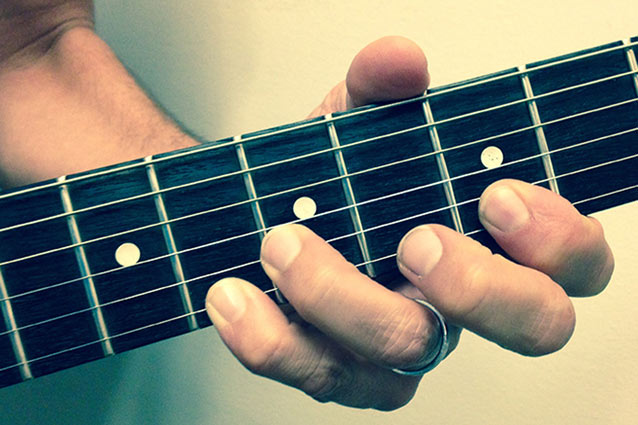Introduction to Spread Triads for Guitar, Part 1

When learning how to play guitar, many of us begin by exploring major and minor triads, often in the open position.
As we advance, we might take these three-note chords up the neck and look at different inversions in our practice routine. But we tend to stop at closed-position triads when checking these shapes out in the woodshed.
While it is important to learn and be able to apply closed-position triads and their inversions to different musical situations, we can open a Pandora’s box of information when we begin to dig into spread-triads on the guitar and their various fingerings and musical applications.
In today’s lesson, we’ll be looking at one such spread triad concept, how it is applied to various triad qualities and how to practice these shapes around different string sets and keys on the fretboard.
Spread Triads Voicing 1
Before we look at the different fingerings for these spread triads on the guitar, let’s take a look at how we will build them from a theoretical perspective. There are several ways to build spread triads on the guitar, and the first approach we will take is to raise the second note of any closed-position triad by one octave. You can see this in the example below, where I have written the three inversions of a C major triad in closed position, followed by the related spread triad next to it.

Practice playing the closed triad and its related spread voicing on different strings and inversions in the key of C, and then in other keys, if possible. Once you’ve spent a few minutes checking out these shapes on the guitar, you’ll be ready to explore all of the different inversions, chord qualities and string sets for the different second-note raised spread triads on the guitar.
All the latest guitar news, interviews, lessons, reviews, deals and more, direct to your inbox!
Major Spread Triads
Here are all the possible Major Spread Triads using the “second note raised” concept. Work these triads in all 12 keys, if possible, to ensure you can play them in any key and any area on the neck when needed.

Minor Spread Triads
You can also flatten the 3rd of each of these chords to produce all of the different inversions, and string sets, for minor spread triads using the same concept. Notice how similar the major and minor spread triads are, with the 3rd of each shape being lowered by one fret to produce the minor triad as compared to the major spread triads you just learned.

Diminished Spread Triads
Though not as common as minor and major spread triads, here are the different inversions and string sets for the diminished spread triads. These shapes are most often used when playing rootless 7th chords, such as using Cdim in place of Ab7, which gives you the 3rd-5th-b7th of the underlying Ab7 chord.

Augmented Spread Triads
Lastly, here are all of the different inversions and string sets for augmented spread triads using the second-note raised concept. After you have learned each of the four spread-triad shapes, major-minor-diminished-augmented, try playing through each of them in a row to test your memory and hear how each triad relates aurally to one another.

Learning triads is an important step in the learning process for any guitarist, especially those exploring the jazz-guitar genre. While we tend to look at closed-position triads regularly in our practice routine, as you can see in the lesson, it is also important to check out spread triads in order to fully explore these important three-note shapes in the woodshed.
Do you have a question or comment about this lesson? Post it in the COMMENTS section below.
Matt Warnock is the owner of mattwarnockguitar.com, a free website that provides hundreds of lessons and resources designed to help guitarists of all experience levels meet their practice and performance goals. Matt lives in the UK, where he is a lecturer in Popular Music Performance at the University of Chester and an examiner for the London College of Music (Registry of Guitar Tutors).
Matt Warnock is the owner of mattwarnockguitar.com, a free website that provides hundreds of lessons and resources designed to help guitarists of all experience levels meet their practice and performance goals. Matt lives in the UK, where he teaches Skype guitar students all over the world, and is an examiner for the London College of Music (Registry of Guitar Tutors).
